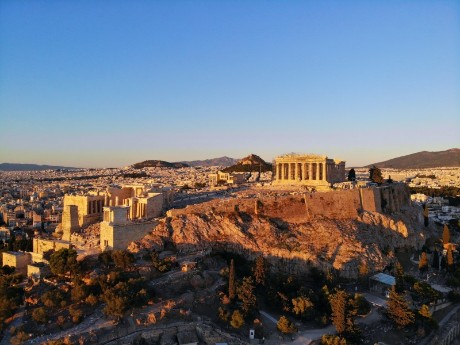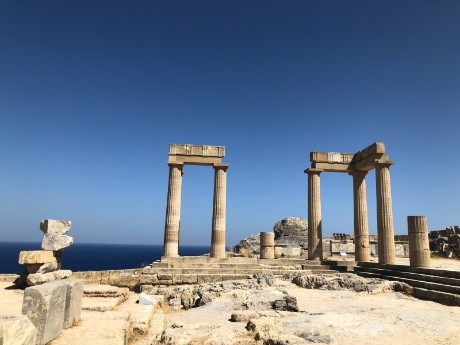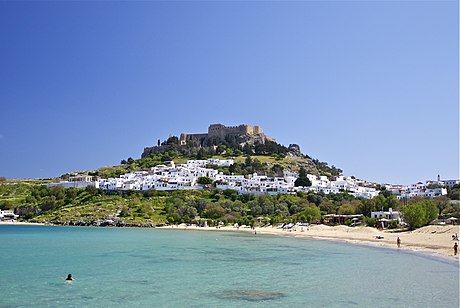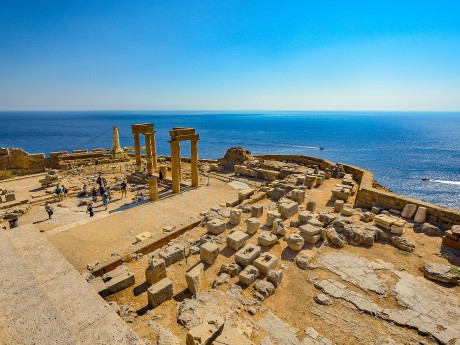Greece & Greek Islands: Athens, Rhodes & Lindos
Immerse yourself in the birthplace of western culture as you explore age-old Greek edifices, venture to cultural landmarks like Athens Acropolis, and savour the island allure of Rhodes and Lindos. Start your trip in Athens, where you can tour Europe's oldest capital and take in the country's rich history. Then, fly to Rhodes, where you can immerse yourself in a perfect combination of culture and nature.
Read more
Immerse yourself in the birthplace of western culture as you explore age-old Greek edifices, venture to cultural landmarks like Athens Acropolis, and savour the island allure of Rhodes and Lindos. Start your trip in Athens, where you can tour Europe's oldest capital and take in the country's rich history. Then, fly to Rhodes, where you can immerse yourself in a perfect combination of culture and nature. Visit the Archaeological Museum of Rhodes, spend a day at Elli Beach or go island hopping on exciting cruise tours, the options are endless. Whether you take the boat, the bus or rent a car from Rhodes to Lindos, one thing remains true, you will not be disappointed by Lindo's beaches and its monumental Acropolis. Whether you're a history buff, a nature lover, or simply enchanted by the country's stunning landscapes, Greece has something to offer everyone. With its rich history, culture, breathtaking scenery, and friendly locals, Greece promises to be a destination that will capture your heart and leave you yearning to return. Waterviews strives to offer accommodation options within walking distance of water and/or in an area of touristic interest. Our prices include taxes (but excludes local tourist taxes). Customize your trip to your personal preferences with optional activities (hit the “Add Activities’’) or change hotels, etc. Contact us for customization at no extra cost at: Service@waterviewstravel.com
Destinations
- Athens
- Rhodes (city)
- Lindos
Itinerary
Athens

Athens is recognised across the world for its incredible history as the birthplace of Ancient Greece and of Western civilization, yet the city has much to offer besides its past. The buzzing and cosmopolitan atmosphere and vibrant cultural scene go hand-in-hand with ancient temples and churches, and visitors will find everything from excellent cuisine, nightlife and shopping to archaeological museums and street art. Of course, no visit to Athens would be complete without a visit to the magnificent hilltop Acropolis, the city's crowning glory.
Read more
Athens is recognised across the world for its incredible history as the birthplace of Ancient Greece and of Western civilization, yet the city has much to offer besides its past. The buzzing and cosmopolitan atmosphere and vibrant cultural scene go hand-in-hand with ancient temples and churches, and visitors will find everything from excellent cuisine, nightlife and shopping to archaeological museums and street art. Of course, no visit to Athens would be complete without a visit to the magnificent hilltop Acropolis, the city's crowning glory.
Additional Information
The first pre-historic settlements were constructed in 3000 BC around the hill of Acropolis. According to legend the King of Athens, Theseus, unified the ten tribes of early Athens into one kingdom in around 1230 BC. This process of synoikismos – bringing together in one home – created the largest and wealthiest state on the Greek mainland, but it also created a larger class of people excluded from political life by the nobility.
By the 7th century BCE, social unrest had become widespread, and the Areopagus appointed Draco to draft a strict new law code (hence "draconian"). When this failed, they appointed Solon, with a mandate to create a new constitution (594). This was the great beginning of a new social revolution, which was the result of the democracy under Cleisthenes (508).
In the 5th century BCE, Athens reached the peak of its fame. It was the most powerful Greek city-state, and the center of Greek cultural life, hosting perhaps the greatest cultural advances in all of human history. Fields of study like science, philosophy, history, and medicine were developed for the first time by Athenian scholars in the timeframe between 480 (the battle of Salamis) and 343 (when Aristotle went to Macedonia to assume teaching duties to Alexander the royal heir), known as Athens' "golden age" - although political dominance came to an end after the Peloponnesian War (431-404), most famous because of its History written by the Athenian general and scholar Thucydides, the "Father of scientific History".
Later on, Athens became part of the Macedonian empire under Alexander, and still later part of the Roman Empire. While it was no longer politically significant, its intellectual reputation gave it a special status, until, in the year 529, Emperor Justinian issued an edict imposing a perpetual silence on all its schools, and the empire's intellectual center moved to Constantinople.
Athens was thriving and prosperous during the Crusades, actually benefiting from the Italian trade during this period. However, this fruitful period was short-lived, as Greece suffered badly under the Ottoman Empire, only to recover in the 19th century as the capital of independent Greece. In modern times, the Athens urban area has grown to a population of 3 million. Athens has turned into a large and bustling city, but as a result it also suffers from congestion, pollution, and poverty.
Modern Olympic Games
Athens hosted the 2004 Summer Olympic Games. The entire urban area of Athens underwent major lasting changes that have improved the quality of life for visitors and residents alike. Aside from the new transportation infrastructure that was completed in time for the 2004 Olympics (from new freeways to light rail systems), the city's historic center underwent serious renovation. Most notable among the city's facelift projects are the Unification of Archaeological Sites (which connects the city's classical-era ruins and monuments to each other through a network of pleasant pedestrianized streets) and the restoration of the picturesque neoclassical Thissio and Pláka districts.
The ancient Olympic Games took place in Olympia from 776 BCE to 394 AD. It is a lengthy day trip from Athens to visit Olympia, but quite interesting.
Architecture
Athens was just a small provincial city when it was chosen in the 1830s to serve as the national capital of the modern Greek State. Although it had a prestigious past, the city's political, economic and cultural importance had declined over the centuries, leaving behind only its classical ruins as a reminder of better times. With the decision to move the national capital from Nafplio to Athens, architects and city planners were hired to build a new city next to the classical ruins, with grand neoclassical homes and public buildings, large city squares, green spaces, and wide avenues, making a conscious, decisive turn from the city's Ottoman past. The city regained its importance in Greek civilization, and by 1900 had evolved into a very attractive cosmopolitan city, with abundant neoclassical architecture harking to the nation's past.
The 20th century however, marked the rapid development of Athens. The city suffered minor damage during WWII, and suffered extensive urban planning in the decades that followed, as the nation rapidly industrialized and urbanized. In the 1960s and 1970s, many 19th century neoclassical buildings, often small and private, were demolished to make way for office buildings, often designed by great Greek architects. The city also expanded outward through rash development, particularly towards the west, as its population grew by absorbing job-seekers from the provinces. With the onset of the automobile, public officials reduced the city's public transportation services without foreseeing the traffic gridlock and smog that would menace the city by the 1980s.
By the late 1980s and early 1990s, the city's reality led to a rude awakening among local and national officials and, coupled with the country's new found remarkable prosperity, large scale projects began to slowly regenerate the city and undo some of the damage of recent decades. Over the course of the next 15 years, money was poured into new transportation infrastructure projects, the restoration of surviving neoclassical buildings, the gentrification of the city's historical center and the renovation of many former industrial areas and the city's coastline. The restoration of charming neoclassical buildings in the city's historical center has been accompanied by the construction of attractive post-modern buildings in newer districts; both of which have begun to improve the aesthetic essence of the city. Athens today is ever evolving, forging a brand new identity for the 21st century.
Climate
Spring and late autumn are the best times to visit Athens. Summer can be extremely hot and dry during heatwaves, but this rarely happens. Winter is definitely low season, with the occasional rainy or snowy day, but also an ideal time to save money while enjoying the city without countless other tourists.
Whilst peak traffic hour can be a bit smoggy on the main roads, on most sunny days the skies are azure blue. The main reason attributed for the pollution of Athens is because the city is enclosed by mountains in a basin which does not allow the smog to leave. The government's ban on diesel vehicles within Athens and the early 1990s initiatives to improve car emissions have greatly contributed to better atmospheric conditions in the basin.
Orientation
The sprawling city is bounded on three sides by Mt. Ymettos, Mt. Parnitha and Mt. Pendeli; whilst inside Athens are twelve hills [the seven historical are: Acropolis, Areopagus, Hill of Philopappus, Observatory Hill (Muses Hill), Pnyx, Lycabettus, Tourkovounia (Anchesmus)], the Acropolis and Lykavittos being the most prominent. These hills provide a refuge from the noise and commotion of the crowded city streets, offering amazing views down to Saronic Gulf, Athens' boundary with the Aegean Sea on its southern side. The streets of Athens (signposted in Greek and English) now melt imperceptibly into Piraeus, the city's ancient, and still bustling, port.
Places of interest to travellers can be found within a relatively small area surrounding the city centre at Syntagma Square (Plateia Syntagmatos). This epicentre is surrounded by the districts of the Plaka to the south, Monastiraki to the west, Kolonaki to the east and Omonia to the north. Further afield is the port of Athens, the Piraeus.
The Acropolis is the ancient high city of Athens, a prominent plateaued rock perched high above the modern city with commanding views and an amazing array of ancient architecture, mostly from the Classical period of Ancient Greece, the most famous of which is the Parthenon. A visit to Athens is not complete without visiting the Acropolis; hundreds of tourists each day accordingly make the pilgrimage.
Gentrified during the 1990s and now very popular with tourists, Plaka is a charming historic district at the foot of the Acropolis, with its restored 19th-century neoclassical homes, pedestrianized streets, shops and restaurants, and picturesque ruins from the city's Roman era. Thissio, to the west side of the Acropolis, is very similar and now houses many restaurants and cafes. Between the two is Monastiraki, a very bohemian district increasingly popular with tourists, with stores selling a variety of items including antiques, cookware, souvenirs, arts and crafts, movie posters, punk culture, funky clothing, and pretty much anything you can think of. Another part of Plaka is Anafiotika and is on the northernmost place. There you will find the first university of Athens before it was relocated in central Athens. Its an oasis of calm and quietness, and there are many green spaces which are part of the green space of Acropolis.
Plaka's boundaries are not precisely defined. Clear borders are the Ancient Agora and Plateia Monastiraki on the west, the Acropolis and Dhionysiou Areopayitou street on the south, the Temple of Olympian Zeus and Leoforos Amalias on the south-east, and the west part of Mitropoleos street, up to the cathedral on the north (but Mitropoleos street and Leoforos Amalias, though boundaries, shouldn't be considered part of Plaka, since they have a modern and fairly non-descript atmosphere). The north-eastern and eastern boundaries are a bit less well defined, but if you're south of Apollonos street and west of Nikis street you'll probably feel like you're still in Plaka.
Syntagma Square is named after the Greek constitution (syntagma) that was proclaimed from the balcony of the royal palace that overlooks the square on 3 September 1843. The former palace has housed the Greek parliament since 1935.
Syntagma Square is a good point from which to begin your orientation in the city, and has been beautified within the last few years ago, and the manic Athenian traffic has been re-routed. it contains cafes, restaurants, fast food outlets, a new metro stop, airline offices.. The square serves as an occasional rallying place for demonstrations and public celebrations.
Omonia Square (Plateia Omonias) is the centre of Athens, and is composed of the actual square together with the surrounding streets, open areas and assemblage of grand buildings that include banks and offices. The neighbouring area of Exarcheia (Εξάρχεια) to the north, dominated by the Athens Polytechnic and its famous band of anarchists, is a bohemian district with lots of bars and clubs visited by students, intellectuals and people who are into alternative culture. Kolonaki is near Lykavittos Hill. The district's borders are not very sharply defined; it covers the south and southeast slopes of Lykavettos Hill north of Vassilisis Sofias Avenue. Kolonaki is the posh area of central Athens. Traditionally the home of the in-town rich, it's the location of a number of embassies and several prominent archaeological schools, including The American School and The British School. It also has the city's greatest concentration of trendy fashion boutiques, and many, mostly upscale, cafes, bars and restaurants.
© Sourced from Wikivoyage
Rhodes (city)

Rhodes (Greek: Ρόδος, Ródos) is the largest settlement and capital city of the island of the same name. It is famous as the former site of the Colossus, one of the seven wonders of the ancient world, and as the oldest inhabited medieval town in Europe.
Read more
Rhodes (Greek: Ρόδος, Ródos) is the largest settlement and capital city of the island of the same name. It is famous as the former site of the Colossus, one of the seven wonders of the ancient world, and as the oldest inhabited medieval town in Europe.
Additional Information
6000 people live and work in the same buildings the Knights of St. John lived 6 centuries ago.
Medieval buildings, mosques, traditional fountains, oriental motifs, Byzantine and Gothic churches, shops and cafeterias are scattered throughout the Old Town of Rhodes. There are approximately 200 streets or lanes that have no name, so getting lost is a distinct possibility.
Orientation
For the traveller, Rhodes City falls into four more or less distinct areas. Rhodes Old Town, still enclosed by its medieval wall. Rhodes New Town, north and west of the Old Town, is an extensive and fairly non-descript modern city. New Town's eastern waterfront, containing Commercial Harbor, the yacht and ferry harbour Mandhraki Harbor, and extensive Elli Beach. Acropolis of Rhodes, the ruins of the ancient city, are about 2 km southwest of the Old Town.
Tourist information
© Sourced from Wikivoyage
Lindos

Lindos is a medieval village on the Greek island of Rhodes. It has only seven hundred inhabitants, greatly outnumbered by tourists in the high season. Being one of the main attractions on the island it is often overcrowded in the mornings when the tourist coaches arrive. These usually depart by 12noon, whisking their patrons off for lunch and the next destination.
Read more
Lindos is a medieval village on the Greek island of Rhodes. It has only seven hundred inhabitants, greatly outnumbered by tourists in the high season. Being one of the main attractions on the island it is often overcrowded in the mornings when the tourist coaches arrive. These usually depart by 12noon, whisking their patrons off for lunch and the next destination.
Additional Information
Lindos provides a mix of history and beaches. The village has many historic houses (known as "Captains" houses) often dating from 16th, 17th or 18th century. The village itself is situated on a network of cobbled streets - all of which are entirely pedestrianised. The only modes of transport possible are donkeys and mopeds. The houses are small, whitewashed and sit beautifully on the hillside making it one of the most beautiful places on the island. The charm of this village is maintained by a preservation order which forbids any unauthorised building work to change it.
Legend has it that the village was set up by one of the divine sons of Zeus. It was in fact established by Dorians around 1000BC.
© Sourced from Wikivoyage





